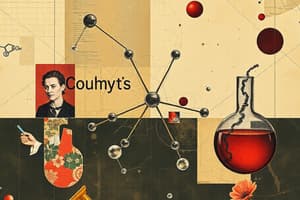Podcast
Questions and Answers
What occurs when a metal atom loses an electron?
What occurs when a metal atom loses an electron?
- It becomes a negatively charged ion.
- It achieves noble gas configuration.
- It becomes a positively charged ion. (correct)
- It forms a covalent bond.
Which statement accurately describes the role of non-metal atoms in ionic bonding?
Which statement accurately describes the role of non-metal atoms in ionic bonding?
- They donate electrons to metal atoms.
- They remain neutral in the bonding process.
- They form bonds by sharing electrons with other non-metals.
- They gain electrons to form negatively charged ions. (correct)
What does Coulomb's Law state about the interaction of charged particles?
What does Coulomb's Law state about the interaction of charged particles?
- It is solely concerned with the energy of covalent bonds.
- It shows that distance has no effect on force.
- It defines how distance and charge affect attraction and repulsion. (correct)
- It only applies to neutral particles.
What indicates a repulsive interaction between two charged ions according to Coulomb's Law?
What indicates a repulsive interaction between two charged ions according to Coulomb's Law?
Which of the following statements about the Octet Rule is true?
Which of the following statements about the Octet Rule is true?
Why are noble gases considered chemically inert?
Why are noble gases considered chemically inert?
During the formation of NaCl, what happens to the sodium atom?
During the formation of NaCl, what happens to the sodium atom?
What happens when sodium loses its 3s electron?
What happens when sodium loses its 3s electron?
What is the result of chlorine gaining one electron from sodium?
What is the result of chlorine gaining one electron from sodium?
Which of the following correctly describes the ionic bond formation between Mg and O?
Which of the following correctly describes the ionic bond formation between Mg and O?
What type of crystal structure is formed by ionic bonds?
What type of crystal structure is formed by ionic bonds?
How do ionic crystals conduct electricity in solution?
How do ionic crystals conduct electricity in solution?
What gives rise to the stability of NaCl in ionic bonding?
What gives rise to the stability of NaCl in ionic bonding?
What do the ions Mg2+ and Cl- form when combined?
What do the ions Mg2+ and Cl- form when combined?
What is the significance of electron transfer in ionic bonding?
What is the significance of electron transfer in ionic bonding?
What does the formation of NaCl illustrate about ionic compounds?
What does the formation of NaCl illustrate about ionic compounds?
What is the correct chemical formula when Ca2+ and O2- ions combine?
What is the correct chemical formula when Ca2+ and O2- ions combine?
When Mg2+ and PO43- ions join to form a compound, what is the correct chemical formula?
When Mg2+ and PO43- ions join to form a compound, what is the correct chemical formula?
Which factor determines the strength of ionic bonds as expressed in Coulomb’s Law?
Which factor determines the strength of ionic bonds as expressed in Coulomb’s Law?
As the size of halogen ions increases from F to I, what happens to the lattice energy of NaF, NaCl, NaBr, and NaI?
As the size of halogen ions increases from F to I, what happens to the lattice energy of NaF, NaCl, NaBr, and NaI?
What is the expected lattice energy relationship between MgO and NaF?
What is the expected lattice energy relationship between MgO and NaF?
What does the variable 'd' in Coulomb's Law represent?
What does the variable 'd' in Coulomb's Law represent?
What is the charge product for NaF in Coulomb's Law?
What is the charge product for NaF in Coulomb's Law?
In comparing ScN and MgO, what is the total charge product for ScN?
In comparing ScN and MgO, what is the total charge product for ScN?
What happens to lattice energy as the distance between ions increases?
What happens to lattice energy as the distance between ions increases?
Study Notes
Coulomb's Law
- Explains the attractive or repulsive energy between two charged particles.
- Positive energy signifies repulsion, while negative energy represents attraction.
- The energy is directly proportional to the product of the charges and indirectly proportional to the distance between them.
Chemical Bonding
- Bonds are formed by atoms or ions joining together.
- Ionic bonding involves ions joining together.
- Covalent bonding involves neutral atoms joining together.
Achieving Chemical Stability
- Group 8A or 18 elements (Noble gases) are chemically stable due to their full outer shell (s2p6 configuration).
- Elements react to gain or lose electrons until they have a full outer shell, usually an octet (8 electrons).
- This is known as the Octet Rule.
Formation of NaCl
- Sodium (Na) has one electron in its valence shell, losing it results in a full n=2 shell and a +1 charge (Na+). It becomes isoelectronic with Neon.
- Chlorine (Cl) has 7 electrons in its valence shell, gaining one electron results in a full n=3 shell and a -1 charge (Cl-). It becomes isoelectronic with Argon.
- Sodium transfers its extra electron to Chlorine, forming an ionic bond.
Ionic Bond - NaCl
- Ionic bonds are formed by the force of attraction between positive and negative ions.
- Sodium and Chlorine ions form a crystal lattice structure as the compound NaCl (salt).
- The key to ionic bonding is the transfer of electrons.
Ionic Bond - MgO
- Magnesium (Mg) has two electrons in its valence shell, losing them results in a full n=2 shell and a +2 charge (Mg2+). It becomes isoelectronic with Neon.
- Oxygen (O) has 6 electrons in its valence shell, gaining two electrons results in a full n=2 shell and a -2 charge (O2-). It becomes isoelectronic with Neon.
- Magnesium transfers two electrons to Oxygen, forming an ionic bond.
Ionic Bond - MgCl2
- Magnesium (Mg) has two electrons in its valence shell, losing them results in a full n=2 shell and a +2 charge (Mg2+). It becomes isoelectronic with Neon.
- Chlorine (Cl) has 7 electrons in its valence shell, gaining one electron results in a full n=3 shell and a -1 charge (Cl-). It becomes isoelectronic with Argon.
- Magnesium transfers one electron to each of the two Chlorine atoms, forming an ionic bond.
Crystal Lattice
- An alternating arrangement of positive and negative ions in three dimensions.
- Forms a solid crystal, like salt.
- Water solutions of ionic crystals conduct electricity.
Lattice Energy and Coulomb's Law
- The strength of ionic bonds depends on Coulomb's Law: Q₁Q₂/d₁₂
- Lattice energy is the attractive energy between two ions.
- Larger charges and smaller distances between ions result in stronger attractions and higher lattice energies.
Summary
- Coulomb's Law explains the attractive and repulsive forces between charged particles.
- Ionic bonding occurs through the transfer of electrons, forming cations (positive ions) and anions (negative ions).
- Ionic compounds often form crystal lattices.
- Lattice energy is influenced by the charges and distances between ions, as described by Coulomb's Law.
Studying That Suits You
Use AI to generate personalized quizzes and flashcards to suit your learning preferences.
Related Documents
Description
This quiz covers the fundamental concepts of Coulomb's Law, chemical bonding, and the Octet Rule. You'll explore how charged particles interact, the types of chemical bonds, and how elements achieve stability. Test your understanding of ionic compounds like NaCl as well.




